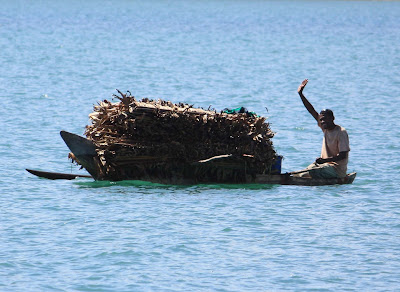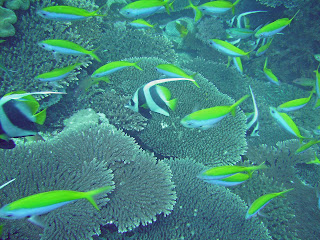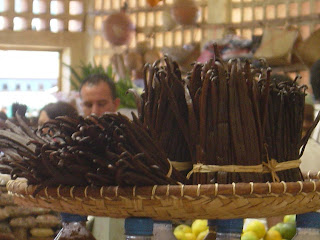Madadagscar wildlife at last!
Our first stop after checking in and stocking up in Hellville was the island of Nosy Komba. There were several guesthouses, restaurants and souvenir shops with tourist customers ferried from Hellville in small boats. One specialty of this island was "reclet," a technique for decorating cloth by embroidering and cutting holes to make table cloths, curtains and wall hangings. We bought a couple that Kim thought would make nice tablecloths.
There were also plenty of other souvenirs for sale, including carvings, paintings and T-shirts. Vanilla beans grew on the island and were offered for sale along with other produce such as bananas and vegetables.
A primary reason tourists came here was to see the endemic Black Lemurs. We paid 2,000 Ar each (about $1) at a ticket office to be guided to a place where Black Lemurs were trained to jump onto tourists in exchange for bananas. Most tourists enjoyed being photographed with lemurs on their shoulders and we were no exception.
Emily was in heaven and at one point had 3 lemurs climbing on her.
A little further up the hill was a village nature park where they kept a boa constrictor (fed a live chicken once a week), a male and a female chameleon, some small Madagascar tortoises and one Seychelles tortoise about 20 years old (much bigger than the others).
One day we took a long walk to the top of the island with Peter and Ulla aboard Lovina. The trail from the village was evidently an old road but no vehicles had climbed it for many years. The road was bordered by huge mango trees and the slopes were thickly wooded except where people had cleared and planted gardens.
Some areas had vanilla vines, cassava and banana plants, and near small clusters of houses were patches of other vegetables. We saw several lizards and a meter long snake along the way.
The crews of Emily Grace and Lovina then headed southwest deep into D'ampasindava Bay and anchored behind Nosy Momoko. The village was on the western side of the island and the anchorage was protected from easterly winds. We all went ashore to locate the village chief (who was a woman here). We presented her with an “I Love the USA” ball cap and a brand new soccer ball we had brought from Malaysia. The chief immediately donned the hat and the soccer ball was a big hit.
We wandered around the village a little and then returned to our boats. As always, Emily entertained the little ones by folding and giving away origami flapping birds and dragons.
One day an abandoned dugout canoe drifted by and we grabbed it and tied it to the back of Emily Grace overnight. Dad and Emily tried a short paddle before giving it back to the village.
Peter and I trolled one day with his dingy, but had no luck. We were catching and sharing Spanish mackerel during the short trips between anchorages so the freezer was still pretty full. It was nice cruising with friends again. Ulla even tried her hand at Origami and we shared meals and dingy trips to shore for most of July.
We returned to Hellville to re-provision and get another 1200 liters of fuel and then we headed north with Lovina. Peter wanted to SCUBA dive and we took him back to Nosy Mitsio and the four brothers. We had a nice time but we dove on the wrong side of the island and missed the great dive conditions we had enjoyed before. Everywhere we have traveled in Madagascar, the people have been smiling and gracious to us.
We had decided to make the 150 mile trip west to Mayotte for a few weeks to explore there and to pick up some parts being shipped in, so we headed south back to Hellville to check out. We plan to spend up to a month in Mayotte and will return to Madagascar for at least one more month before pushing off for South Africa.
Tom



























































